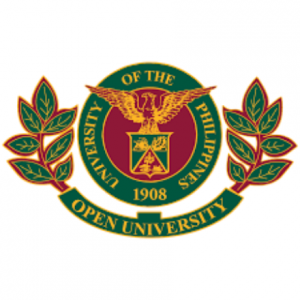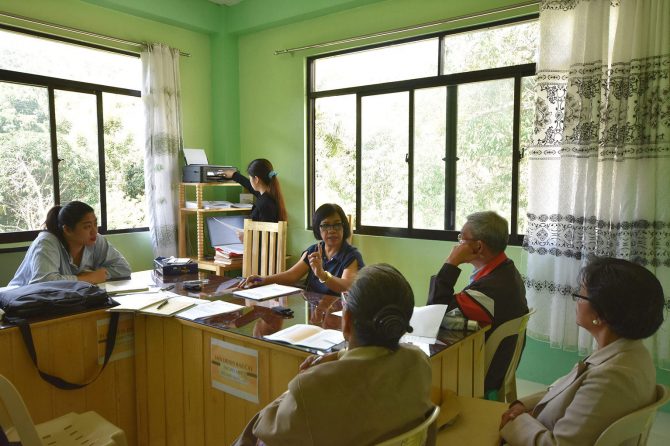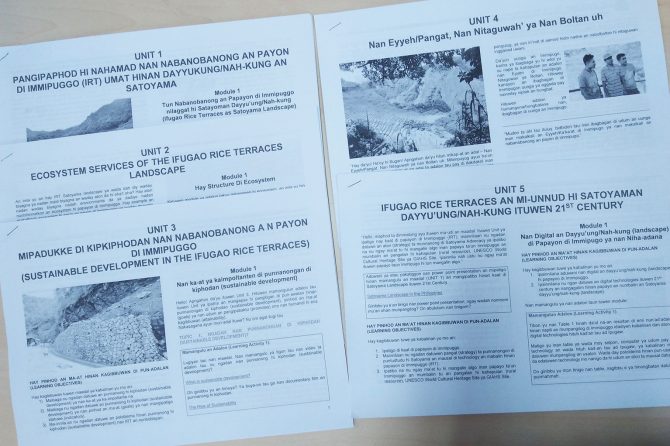2017 PHILIPPINES
Contextualization of the Instructional Materials for the Training of Youths toward Conservation of Ifugao Rice Terraces as a Satoyama Landscape
University of the Philippines Open University (UPOU)
Capacity building
Landscape
Overview
The Ifugao Rice Terraces (IRT), a World Heritage Site since 1996, had been at risk due to degraded conditions including soil erosion, poor maintenance, abandonment of rice terraces, and out-migration of young Ifugaos. To confront the challenges, over the past 10 years there have been many efforts by the local government, non-government organisations, academia, and the private sector to conserve and preserve the IRTI. These efforts have improved the situation and have restored at least 50% of the collapsed terraces as well as documenting and rehabilitating major irrigation systems. However, there is a need for continuous efforts to sustain the conservation and preservation initiatives for the IRT. Previously the UPOU conducted capacity building and youth empowerment in the area and prepared instructional materials to capacitate the Ifugao youths with the knowledge to conserve, preserve and sustainably develop the IRT landscape, culture and heritage. However, these were written in English and were not easily accessible for the indigenous community. Hence, this project aimed to contextualise the instructional materials/modules, which are made up of a total of eighteen modules (divided into five units), through translation into two native languages so that the Ifugao youths and community could have a deeper understanding and appreciation of their cultural heritage and landscape. As a result, the project was able to: validate the content of the instructional materials to the elders and youths of the Ifugao villages; contextualise the instructional materials by translating them into the local languages of Tuwali and Ayangan; and share, conduct and evaluate the translated instructional materials to Ifugao community members.
Key achievements
- The developed instructional materials were translated into the Tuwali and Ayangan languages.
- Making these materials promoted collaboration among various educational, design, and linguistic experts.
- These translated materials add to the existing physical and electronic learning resources on the IRT, which further improves the learning environment for all students/learners nationwide- and globally.
Lessons
- When creating instructional materials intended for a specific audience, it is always important to have user involvement.
- In translating instructional materials, it is essential to meticulously choose translators who are native speakers and have a vast knowledge on the IRT ecosystem services and the Ifugao culture.
- Researching dialects/languages used in a community also needs to be conducted prior to translating any materials.
- Collaborating and having constant communication with team members are also important in executing plans and in delivering services effectively and efficiently.
Project location
Organisation

University of the Philippines Open University (UPOU)
- Sector
- academic/ research institute
- Country
- Philippines
- Website/SNS
- https://www.upou.edu.ph/
Related products
The instructional materials of Unit1 to 5 (Tuwali language)
- Publisher
- University of the Philippines Open University (UPOU)
Instructional materials were developed and written by UPOU and IFSU project members, as well as teammates from UPLB, BSU-OU and MPSPC. The materials were the consolidated outputs of another project, the Youth for Ifugao Rice Terraces (Y4IRT) funded by Mitsui & Co., Ltd. This project proposed and approved by SDM is a ‘sister’ project of Y4IRT—the contextualization of the instructional materials through translation. A total of 18 English modules were developed and were divided among 5 Units—those units discussed the following: IRT as a Satoyama Landscape; Ecosystem Services of the IRT Landscape; Sustainable Development in the IRT; My Culture, My Nature and My Heritage; and, IRT as a Satoyama Landscape in the 21st Century. Each unit contained various topics (related to its main idea), learning activities (such as interviewing other community members, taking photos and videos, drafting action plans and scripts, posting on social networking sites), photos and videos (related to a topic), and self-assessment questions.
The instructional materials of Unit2 (Ayangan language)
- Publisher
- University of the Philippines Open University (UPOU)
Instructional materials were developed and written by UPOU and IFSU project members, as well as teammates from UPLB, BSU-OU and MPSPC. The materials were the consolidated outputs of another project, the Youth for Ifugao Rice Terraces (Y4IRT) funded by Mitsui & Co., Ltd. This project proposed and approved by SDM is a ‘sister’ project of Y4IRT—the contextualization of the instructional materials through translation. A total of 18 English modules were developed and were divided among 5 Units—those units discussed the following: IRT as a Satoyama Landscape; Ecosystem Services of the IRT Landscape; Sustainable Development in the IRT; My Culture, My Nature and My Heritage; and, IRT as a Satoyama Landscape in the 21st Century. Each unit contained various topics (related to its main idea), learning activities (such as interviewing other community members, taking photos and videos, drafting action plans and scripts, posting on social networking sites), photos and videos (related to a topic), and self-assessment questions.
Relevant projects
Projects of the same year
Aichi Biodiversity Targets
Aichi Biodiversity Targets
-
Knowledge improved, shared and applied
Sustainable Development Goals
Sustainable Development Goals
-
Climate action
-
Life below water
-
Life on land

